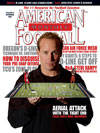AMERICAN FOOTBALL MONTHLY THE #1 RESOURCE FOR FOOTBALL COACHES
Article CategoriesAFM Magazine
|
Evaluation: The One Constantby: Jonathan SmithQuarterbacks Coach, University of Idaho © More from this issue As coaches, we've all heard these terms... Coachability Ability to Learn Willingness to Learn Ability to Trust Willingness to Trust Leadership / Good Teammate Team before Self Responsibility Help Others Competitive Play their best Seek Challenge Instinctive Ability Toughness Athleticism Explosiveness Explosive Fashion @ POA Explosive Fashion in open field Ability to Bend Athletic Position Change of Direction Re-Direct without wasted movement Balance Never move in wrong direction Ball Skills / Handwork Synchr....The full article can only be seen by subscribers. Subscribe today!
|
|
|||||||
| HOME |
MAGAZINE |
SUBSCRIBE | ONLINE COLUMNISTS | COACHING VIDEOS |
Copyright 2025, AmericanFootballMonthly.com
All Rights Reserved





